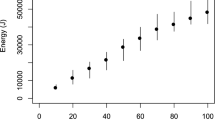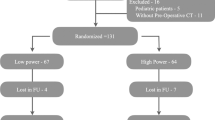Abstract
Purpose
To study the impact of stone density as assessed by Hounsfield units (HU) on total laser energy (TLE) used and total laser time (TLT) spent in complete fragmentation of upper urinary tract stones. In addition, we also studied the impact of stone composition on the laser energy and time required for fragmentation.
Methods
Thirty consecutive patients fulfilling inclusion and exclusion criteria were included in the study. Patients with renal or proximal ureteral stones with a size of 5–20 mm were included. Stone fragmentation was performed using Ho:YAG 100 W laser and TLT and TLE were correlated with the HU and stone composition.
Results
The mean stone diameter was 10.83 ± 3.5 mm and the mean HU was 893 ± 315. The mean TLE and TLT were 8.86 ± 3.12 kJ and 18.46 ± 6.9 min, respectively. We observed a strong positive correlation between HU and TLE (r = 0.84, p value < 0.001) and between HU and TLT (r = 0.58, p value = 0.001). However, the stone composition did not influence the lasering energy (p value = 0.36) and lasering time (p value = 0.30). Stone diameter also had significant positive correlation with TLE (r = 0.41; p = 0.02) and TLT (r = 0.54; p− 0.002). When controlling for stone size the correlation of HU with TLE (r = 0.83; p < 0.001) and TLT (r = 0.52; p = 0.004) remained significant.
Conclusions
HU and stone diameter are significant predictors of TLE and TLT when using Ho:YAG laser for stone fragmentation. However, stone composition and stone location failed to show any significant effect on either of these parameters.
Similar content being viewed by others
References
Turk C, Neisius AP, Seitz C, Skolarikos A, Knoll T (2019) EAU guidelines on urolithiasis. Available at: https://uroweb.org/guideline/urolithiasis/. Accessed 15 Dec 2019
Leveillee RJ, Lobik L (2003) Intracorporeal lithotripsy: which modality is best? Curr Opin Urol 13(3):249–53. Available at: https://insights.ovid.com/pubmed?pmid=12692450 Accessed May 2003
Bader MJ, Gratzke C, Hecht V, Schlenker B, Seitz M, Reich O et al (2011) Impact of collateral damage to endourologic tools during laser lithotripsy—in vitro comparison of three different clinical laser systems. J Endourol 25(4):667–672. https://doi.org/10.1089/end.2010.0169
Floratos DL, de la Rosette JJ (2001) Lasers in urology. BJU Int 84(2):204–211. https://doi.org/10.1046/j.1464410x.1999.00163.x
Onal B, Tansu N, Demirkesen O, Yalcin V, Huang L, Nguyen HT et al (2012) Nomogram and scoring system for predicting stone-free status after extracorporeal shock wave lithotripsy in children with urolithiasis. BJU Int 111(2):344–352
Teichman JM, Vassar GJ, Glickman RD (1998) Holmium: yttrium-aluminum-garnet lithotripsy efficiency varies with stone composition. Urology 52(3):392–7. Available at: https://www.goldjournal.net/article/S0090-4295(98)00239-8/fulltext Accessed Sept 1998
Ito H, Kawahara T, Terao H, Ogawa T, Yao M, Kubota Y et al (2012) Predictive value of attenuation coefficients measured as Hounsfield units on noncontrast computed tomography during flexible ureteroscopy with holmium laser lithotripsy: a single-center experience. J Endourol 26:1125–30. https://doi.org/10.1089/end.2012.0154
Ofude M, Shima T, Yotsuyanagi S, Ikeda D (2017) Stone attenuation values measured by average hounsfield units and stone volume as predictors of total laser energy required during ureteroscopic lithotripsy using Holmium:Yttrium-Aluminum-Garnet lasers. Urology 102:48–53. Available at: https://www.sciencedirect.com/science/article/pii/S0090429516307476 Accessed Apr 2017
Molina WR, Marchini GS, Pompeo A, Sehrt D, Kim FJ, Monga M (2014) Determinants of Holmium:Yttrium-aluminium-garnet laser time and energy during ureteroscopic laser lithotripsy. Urology 83(4):738–44. Available at: https://www.ncbi.nlm.nih.gov/pubmed/24486000. Accessed Apr 2014
Wiener SV, Deters LA, Pais VM Jr (2012) Effect of stone composition on operative time during ureteroscopic holmium:yttrium–aluminum–garnet laser lithotripsy with active fragment retrieval. Urology 80(4):790–794. Available at: https://www.ncbi.nlm.nih.gov/pubmed/22854140
Kronenberg P, Traxer O (2015) Update on lasers in urology 2014: current assessment on Holmium:Yttrium-Aluminum-Garnet (Ho:YAG) laser lithotripter settings and laser fibers. World J Urol 33(4):463–469. Available at: https://www.ncbi.nlm.nih.gov/pubmed/25185524. Accessed 5 Dec 2019
Knudsen BE (2019) Lasee fibers for Holmium:YAG lithotripsy: what is important and what is new. Urol Clin North Am 46(2):185–191. https://doi.org/10.1016/j.ucl.2018.12.004
Aldoukhi AH, Black KM, Ghani KR (2019) Emerging laser techniques for management of stones. Urol Clin North Am 46(2):193–205. https://doi.org/10.1016/j.ucl.2018.12.005
Elhiali MM, Badaan S, Ibrahim A, Andonian S (2017) Use of moses technology to improve Holmium laser lithotripsy outcomes: a preclinical study. J Endourol 31(6):598–604. https://doi.org/10.1089/end.2017.0050
Stern KL, Monga M (2018) The moses holmium system-time is money. Can J Urol 25(3):9313–9316. Available at: https://www.canjurol.com/abstract.php?ArticleID=&version=1.0&PMID=29900818. Accessed Jun 2018
Funding
No funding.
Author information
Authors and Affiliations
Contributions
RSR: conceptualization, data collection; data analysis; initial draft of the manuscript. MHA: conceptualization, critical review of the manuscript.
Corresponding author
Ethics declarations
Conflict of interest
Authors declare no conflict of interest.
Ethics approval
Study was pre-approved by ERC of the University.
Informed consent
An informed consent was obtained prior to accrual.
Additional information
Publisher's Note
Springer Nature remains neutral with regard to jurisdictional claims in published maps and institutional affiliations.
Rights and permissions
About this article
Cite this article
Rana, R.S., Ather, M.H. Hounsfield units-a significant predictor of lasering time and energy in the management of upper urinary tract stones using Holmium: Yttrium–Aluminum Garnet lasers. Int Urol Nephrol 52, 1637–1641 (2020). https://doi.org/10.1007/s11255-020-02442-w
Received:
Accepted:
Published:
Issue Date:
DOI: https://doi.org/10.1007/s11255-020-02442-w




